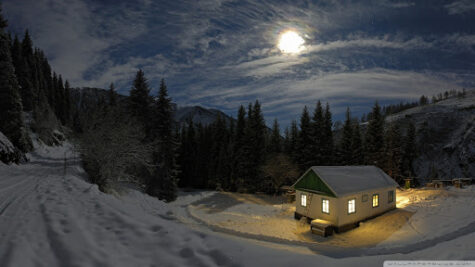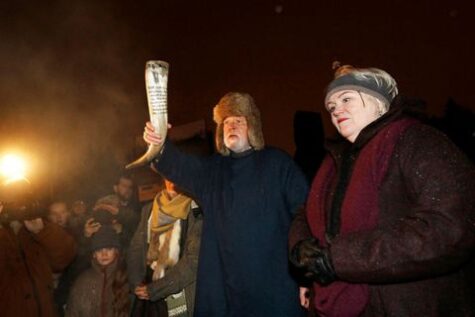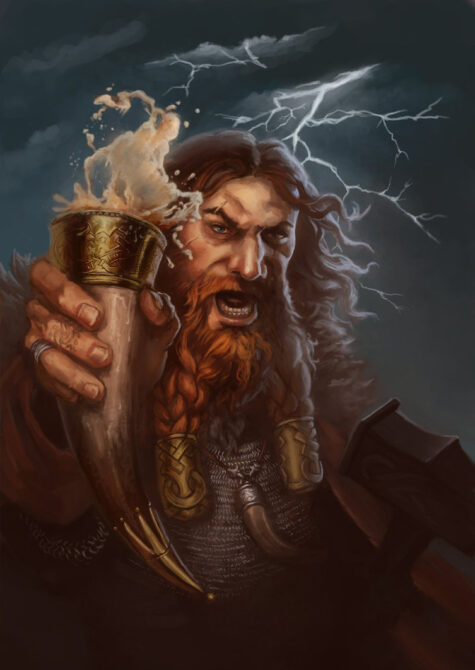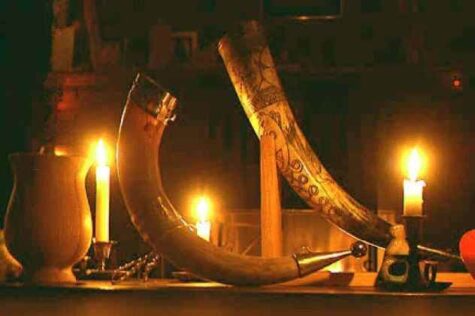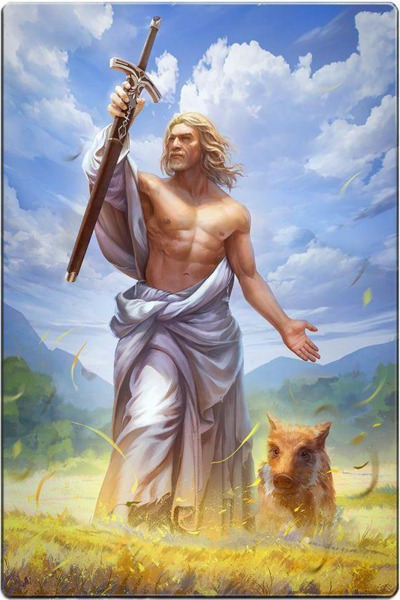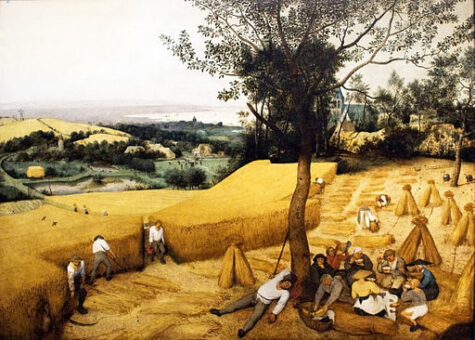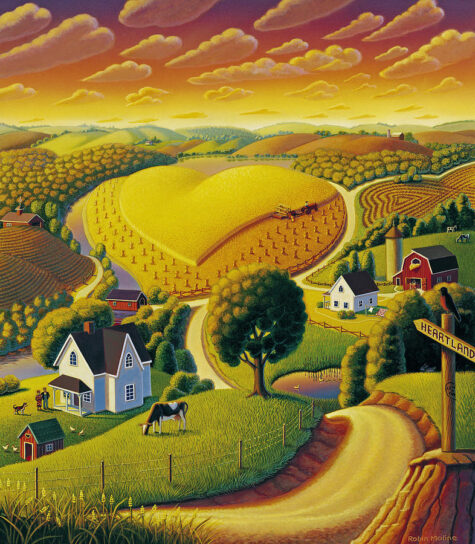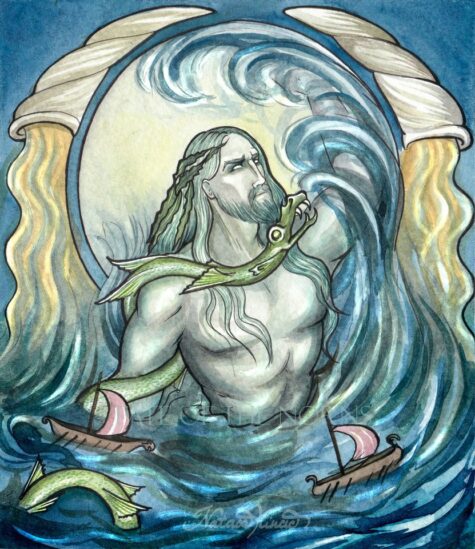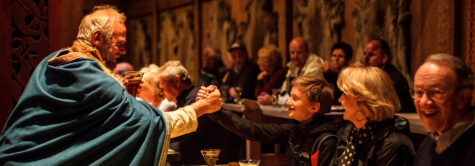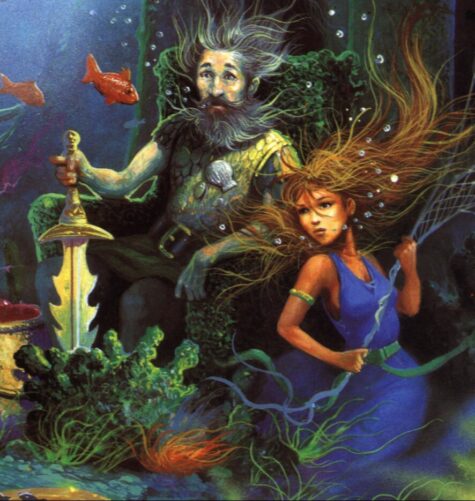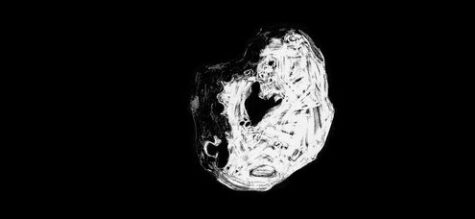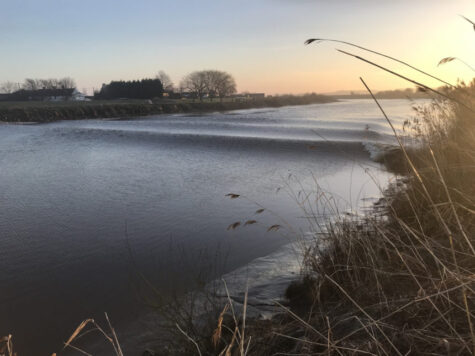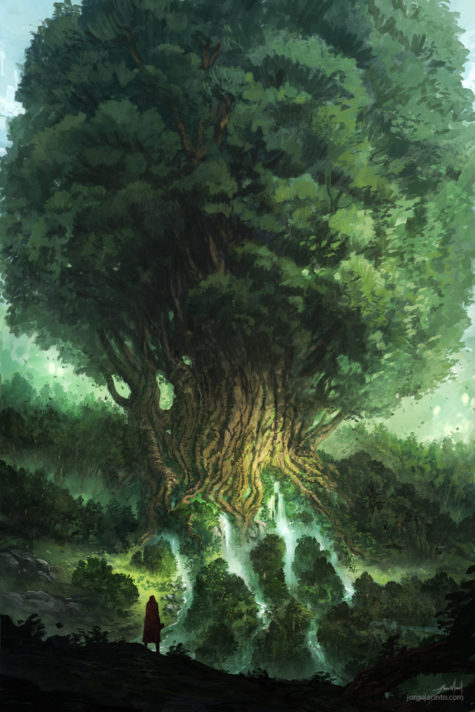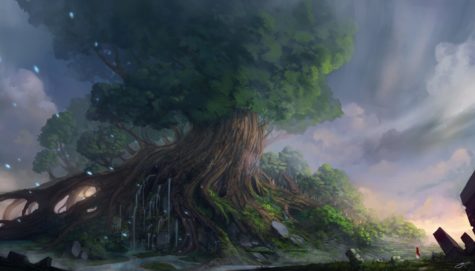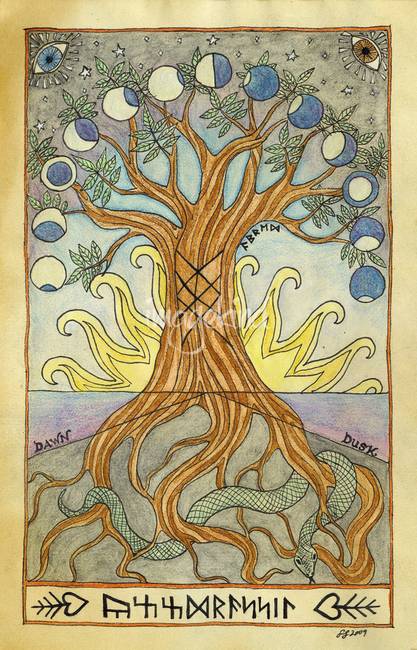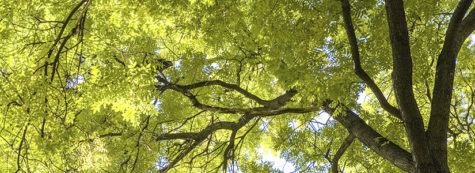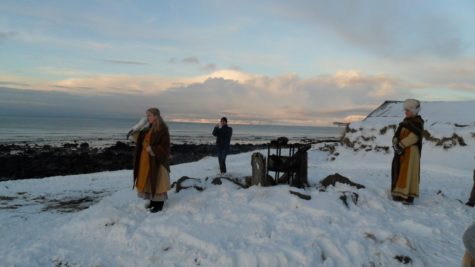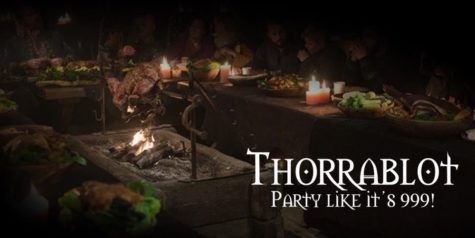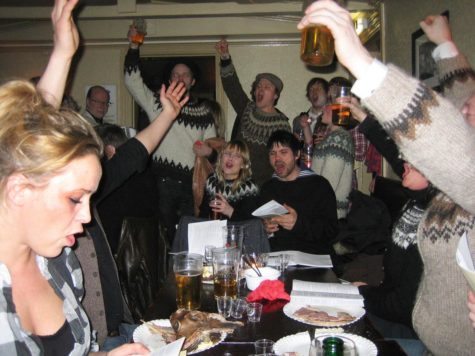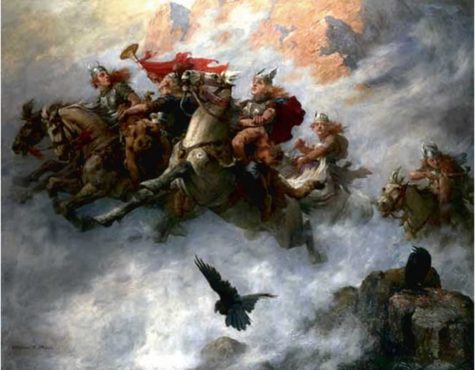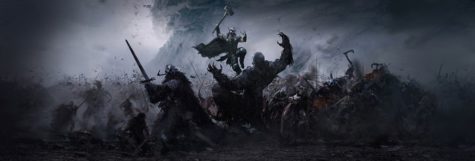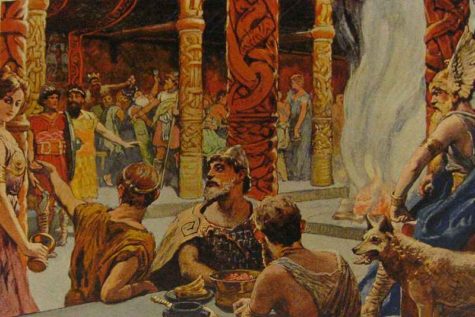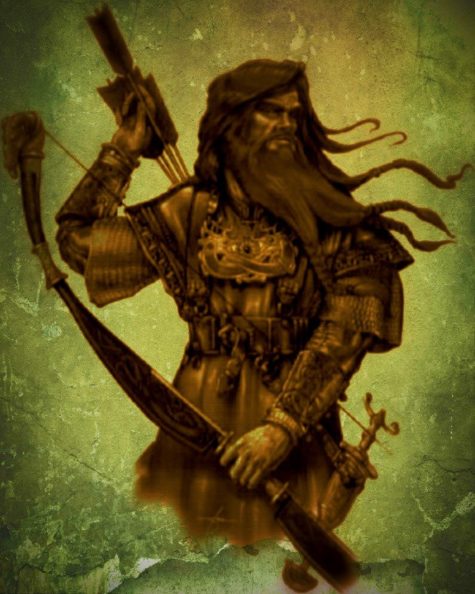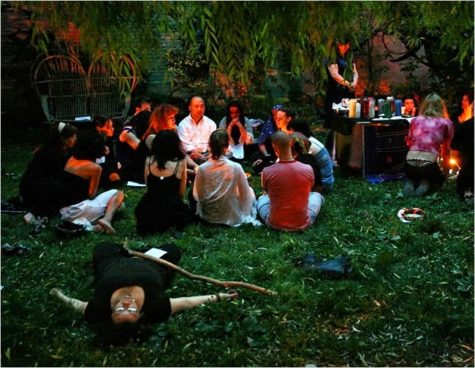Norse and Viking Festivals
In the Old Icelandic Calendar, winter begins on the Satyrday between Hunting 11th and 17th. This festival marks the beginning of winter, which was often celebrated around the middle of October. Winter Nights celebrates the bounty of the harvest
- Also referred to as: Vetrablot, Vetrnætr, Winterfylleth, Veturnætur, Winter Finding, and Winter Day.
Winter Nights is a more accurate term, considering that the passage of time was marked by nights, not days. An example of this can be seen from Anglo-Saxon times as it applies to the English word ‘fortnight’ as a reckoning of time for two weeks.
Just as traditional Jewish sabbat begins at sundown on Friday until sundown on Saturday… it appears that the festivities traditionally kicked off at night. This allows participants to work to prepare for the party during daylight hours too. On occasion you may even see reference to the term Winter Finding.
Some groups use this as being synonymous and interchangeable with the term Winter Nights. But others will call the harvest celebration at the autumnal equinox Winter Finding, and call the later October celebration Winter Nights instead.
Though we know the various names of the holiday, we don’t really know how people celebrated Winternights. Some people honored Freyr at this holiday, where He was given a sacrifice to thank him for the year’s harvest.
Some traditions honor Freya and the fertility and protective spirits called Disir, that She leads (often the Disir are seen as our female ancestors). Glory is given to Freya, a libation of ale, milk, or mead was poured into the soil as an offering to the Disir and the Earth itself.
We know that in Sweden, an event called an Alfarblot was held around the same time of year. It was a private event where ale was served and livestock were likely sacrificed. As Freyr is the lord of Alfheim, this event may be related to Winternights.
Some people honored Odin instead; some honored the dísir (female ancestors), some honored the alfar (elves; or male ancestors). Some people likely did a mix of all of the above.
When celebrating Winternights with a definite disir/alfar focus. Food is shared at a potluck based on recipes passed down to us from our ancestors or foods that they preferred. A sumbel is in their honor, honoring specifically those who have passed on in the last year, both animals and humans, and then sharing the stories of the food we brought, and of our ancestors of blood and of spirit. This can be an intimate, moving ritual, and a great way to start the winter season.
- A Sumbel is a formal drinking ritual composed of toasting, hails, oath-taking, the recitation of poetry or song, and other forms of verbal expression.
A Winternights sumbel might start with a round to Freyr to thank Him for the past harvest and to ask for prosperity in the days ahead. A round is included for the recently departed and for our ancestors of blood and of spirit as well.
So today we have a range of practice as it applies to this time of year. Some opt to celebrate it at the time of the autumnal equinox for sheer simplicity. But many others will instead decide to observe Winter Nights in October as that’s more in keeping with the traditional calendars.
Others split the celebration up, observing a Harvest-tide celebration in September, and then in October they will instead opt to specifically come together to honor the ancestors.
If you have children, incorporating ancestor veneration at this time helps to sync up to the Halloween and Day of the Dead décor that is on the market, and allow the children to have some similar dialogue among their peers at school. What Winternights does have in common with modern Samhain and Day of the Dead traditions, is that we both honor ancestors with their favorite foods and drink.
A Blot for Winternights
I hope all Heathens have a satisfying Winternights for both the living and the dead this year . Hail the disir! Hail the alfar! Hail Freyr!
- Hallowing:
Thunar, Guardian of Asgard and Midgard, We ask you to ward this stead well for Winternights. Hail Heimdall warder of Bifrost we ask that you hold us in your great sight.
- Purpose:
We gather to honor the Aesir and Vanir on this Winter Night and give thanks for the fruits of this past year and the Harvest we have gathered from the Earth. We also look back on the past year and measure our time that it was used wisely; to look at the future to find our way; like the Ice of time scrubbing away the impurities to leave behind the clear work.
We ask the dwellers of Asgard to give us the strength to and to help us provide for our kinsman in preparation for the long Winternachten yet to come.
- Hails:
Hail Wodan, The All Father, for your wisdom and forethought in guiding us forward through the winter to come and for the knowledge you have shared with us.
Hail Wodan!
Hail to Fro Ing for the bountiful harvest you have brought to us this eve.
Hail Fro Ing!
Hail to Freya for the love and life we hold to our hearts.
Hail Freya!
Hail to all the Ases and Wanes for the mighty work that you do.
Hail the Ases and Wanes!
And Hail to our Ancestors and Wights of the land. Hail to the All who have crossed Bifrost before.
Hail the Ancestors!
- Welcoming:
We welcome all the Ases and the Wanes. We welcome all the Wights, Alfs and Ancestors who have gone before us. We Welcome all the Wights and Landvaetter to witness this rite rightly done so that you shall see the truth in our hearts.
Heilsa all!
The time of Winternights marks the passing of Sunna farther down into the sky. This time of year marks the Mother Earth going to sleep to be rested for the coming Spring; for Fro Ing to renew the fertility of the Earth to bring forward the crops of our folk.
We look forward to Yule that is fast approaching. And we honor our ancestors that have gone before us. We look back over this past year with pride of the work rightly done. We look forward to prepare for the coming of winter, to protect our hearth and Kin from the cold of the frost giant called Winter, to open our hearths to those in need.
With this hallowed drink, brewed with the hand of Aegir the Brewer of Asgard we give our toasts:
- Wassail All!
Hail to the Aesir and Vanir!
Hail to the Alfs and the Dises!
Hail to our Ancestors!
Hail to the Landvaetter and all Wights of weal!
We now offer this sacrifice and return it to the Earth.
- Personal Hails!
Heilsa!
- The Blessing and Ending
We thank the Gods and Goddesses, the Aesir and Vanir for the gifts that we have and the gifts we may receive, May you find us fitting to receive them.
Heilsa All!
Sources:
- Asatru Utah
- Patheos
- Wyrd Designs
- Erich Shall
- Grundair Karlson
Freyfaxi, Freysblöt, or Hlæfæst (which means Loaf Feast) which celebrates the beginning of the harvest. There is no specific “correct” date for this harvest festival; some groups celebrate it at the beginning of the month (to coincide with Lammas), some mid-month, and some on the full moon.
Freyr is the Norse god of fertility and harvest and a blöt is a sacrifice or offering to a god. So Freysblöt is offerings to Freyr, this is done in celebration of the beginning of harvest. The feast is also thought of as holy to Thor as a harvest God and his wife Sif, whose long golden hair can be seen in fields of ripe grain.
The first sheaf of harvested grain was bound and blessed for the gods and the vaettir (land or place spirits). Bread baked from the first harvest was also made into an offering and shared with the community.
In Viking times this is also when the warriors who had gone off to fight at the end of planting season came back, loaded with a summer’s worth of plunder and ready to reap the crops that had ripened while they were gone. It is almost like American thanksgiving, feasting and celebrating the first fruits and grains from harvest.
In modern times this is often just before back-to-school giving families and kindreds a good opportunity to celebrate together before the added stresses of homework and extracurricular activities. While the celebrations were modest compared to some of the other major holidays it was still an excellent reason to gather in celebration and to recognize the prosperity in our lives.
Since it draws from First Harvest traditions, the dates would vary regionally, but falls sometime in the beginning of August, because that is when many of our gardens are coming into full production. Typically in the northern hemisphere it is around this time that we celebrate the bounty of the Earth, and the gifts that she brings us with the help of Frey.
In truth, “Freyfaxi” is basically made up and can be celebrated by any group that wants to when they want to. It isn’t wholly without reference, as it draws on a history of First Harvest traditions, but it isn’t historical by any means. Wikipedia pins it on August 1st, the Ásatrú Alliance’s holidays page dates it as August 19th, and many Pagan Calendars date it to August 23rd.
Loaf-Feast is the end of the summer’s vacation, the beginning of a time of hard work which lasts through the next two or three months, while we ready ourselves for the winter.
The holiday of FreyFaxi was much more important for the lives of our ancestors that it is today. Without a good harvest, many many people would perish in the winter. We honor Frey to thank him for the many harvests that we have had, if there was one terrible one, some of us may not be here today. Thanks to Frey we are. If a year was particularly horrible, drastic sacrifice would be used – animal, or even human in some cases.
Even though many of us are no longer farmers, we still depend on the land for all that we are given. Maybe we do not depend on it directly but most of us go to the grocery store and buy things that have come from the fields. This is a time to honor Frey, god of the harvest, rains, and fertility. A time to thank him for the bounty of the earth, and all the gifts that he bestows upon us.
Today we honor him with mead, or some type of drink, food from our table, typically foods we harvest ourselves, for example baked bread that we have made ourselves from the wheat he has bestowed upon us. It is traditional to mark the holiday by baking a figure of the God Freyr in bread, and then symbolically sacrificing and eating it. Any way that you honor Frey, is a good way. Traditionally however, it is with a blot and feast.
We honor him because without him, simply we would not have much of our food supply, and quite obviously without that, we do not have much at all! He bestows fertility to the fields and plants, gives them life, giving rain so that they may grow and flourish. These plants including trees, give us oxygen. So if you are not going to honor Frey, son of Njord, for the bounty of the land at least honor him for the life of the plants and world around us!
We honor Frey by giving him a blot, and a grand feast from our own gardens and the fields. (If you do not have these things at least go spend some money and get a few things from a farmers market or something similar). We thank Frey, and honor him for the harvest and the fertility of the land and ask him to give the land even greater fertility in the coming year and in the dark of winter.
Sources:
According to some calendars, March 3rd is Aegir’s Day, this has also been referred to as the Celtic Sea Festival. The Pagan Book of Hours has a day for Aegir and Ran listed as July 25.
Ægir or Aegir is a Norse sea jötunn, a mythological giant (sometimes called a Frost Giant) and God of the sea. He’s also the brewer to the gods of Asgard. Aegir is also a God of brewing known for the beer he brewed in an enormous cauldron stolen from the giants by Thor and Loki. (Read that story here: Aegir’s Feast.)
He hosted elaborate parties, providing home-brewed ale in enormous pots. His mugs would magically refill themselves with more ale.
Married to the goddess Ran, they have nine daughters who each personify different kinds of waves.
Party and Celebration Ideas
To celebrate, have a party with a local microbrew and smørrebrød.
Roast Beef & Pickle Smørrebrød
- 1 slice rye bread, crust trimmed off
- 1/2 teaspoon unsalted butter, slightly softened
- 1/8 lb. sliced roast beef, cut into squares
- 2 to 4 cornichons (gherkins), thinly sliced lengthwise
- fried onions, (recipe below)
- 1 teaspoon prepared horseradish
Spread bread evenly with butter. Arrange roast beef on butter. Arrange cornichons and onion on top. Top with a dollop of horseradish.
Fried Onions
- Thinly slice a white onion.
- Soak in cold water for 10 minutes.
- Drain, then dredge onion in flour.
- Fry in hot oil until golden brown.
Ceremony for the Day of Aegir and Ran
- Date: July 25 – also known as 25 Haymonath
- Colors: Sea-blue, sea-green.
- Element: Water
- Offerings: Singing. Blood given to the ocean. Aid those who clean the seas.
- Song: Harp Song of the Dane Women, along with any other sea songs, sung as offerings.
- Daily Meal: Seafood.
Altar:
Upon cloth colored like the sea place shells, nets, figures of fish, sea floats, and anything that comes from the sea. Place there also a cup of wine with flecks of gold in it.
Invocation to Aegir, Ran, and the Nine Sisters
Lord and Lady of the Depths,
Keepers of the great flocks and herds
That float by the millions
Through glass-green waves,
Lady Ran of the ten-times-fingering weed,
Your hair spread throughout the worlds,
Lord Aegir of the great currents
And the waves that keep the ship afloat,
Generous in your bounty,
Capricious in your favor,
Brewer of ale for gods and lost souls,
Keep us safe as we pass over your realm
In life, in dreams, and in mystery.
Nine Sisters of the Waves, Sacred Undines,
Daughters of Aegir and Ran, fish-tailed,
Blood on your hands and beauty in your song,
We hail you from the shores, the depths, the heights of sea-cliffs.
Kolga the Cold One, Ice-Maiden of the floes and castles.
Duva the Hidden One, Keeper of island treasures.
Blodughadda, Blood-Haired One, shark’s delight.
Hronn, Sucking Whirlpool, Eel-daughter and Mistress of Fear.
Hevring, Heaving Storm, Mourning’s Mistress.
Bara, Great Wave of the Whale, battering the land’s stalwart stand.
Bylgja, Breaker’s Dancer, Rider of the Wave-Horse.
Unn, Billowing Tides, Maiden of the Counting Moon’s Rhythm.
Himinglava, Fair-Weather Mermaid, Sun Shining Through.
Teach us by the Powers of Water
How to find the way to our own souls.
Petitioning Aegir
Aegir is the presiding spirit of the ocean. He may also be understood as actually being the ocean. This ancient deity is beloved but feared. Petition him for safety on the seas and to reveal the secrets of the deep. Aegir knows everything. He is a well of knowledge and can theoretically fill any request or recruit another deity who can.
Petitions should always be accompanied with offerings. An altar may be built for him, or offerings may be brought to the sea. Be generous. He’s a king.
Give him objects reminiscent of the sea. Give him fine old coins – sailors once carried them so that in case they drowned, they wouldn’t arrive at Aegir’s hall empty handed. Serve him mead and ale, acknowledging that you know it’s nowhere near as good as what he serves at home.
Aegir – The Moon
Aegir, originally called S/2004 S10, is a natural satellite of Saturn. Its discovery was announced on May 4, 2005, from observations taken between December 12, 2004, and March 11, 2005.
Aegir is a member of the Norse group of moons. These “irregular” moons have retrograde orbits around Saturn—traveling around in the opposite direction from the planet’s rotation. Aegir and the other Norse moons also have eccentric orbits, meaning they are more elongated than circular.
Like Saturn’s other irregular moons, Aegir is thought to be an object that was captured by Saturn’s gravity, rather than having accreted from the dusty disk that surrounded the newly formed planet as the regular moons are thought to have done.
Aegir is about 6 kilometres in diameter, and orbits Saturn at an average distance of 19,618 Mm in 1025.908 days, at an inclination of 167° to the ecliptic (140° to Saturn’s equator), in a retrograde direction and with an eccentricity of 0.237.
The moon was named in April 2007 after Ægir, a giant from Norse mythology, the personification of tranquil seas, the one who soothes storms away. He is a son of Fornjót, and brother of Logi (fire, flame) and Kári (wind).
The name may be pronounced various ways. /ˈaɪjɪər/ (with the ‘g’ pronounced as a y-sound) approximates modern Norwegian and Icelandic. /ˈæɡɪər/ (with a hard ‘g’) approximates what the Old Norse may have sounded like, while the Latinized/spelling pronunciations /ˈiːdʒɪər/, /ˈɛdʒɪər/ and /ˈeɪdʒɪər/ are also found.
Aegir – the Tidal Bore
Aegir also gives his name to the tidal bore on the river Trent (in England) which is particularly powerful around the equinoxes. At certain times of the year, it is possible to see a bore of up to five feet high.
Aegir is said to rush up the river to try and reclaim the surrounding land and expand his watery kingdom.
The Trent Aegir is also known as the Eagre. The Aegir occurs when a high spring tide meets the downstream flow of the river forcing it back and causing a wave to flow upstream. Typically it is possible to see the bore from Derrythorpe to as far up the river as Gainsborough. Beyond Gainsborough the bore is reduced to a ripple.
The best places to see the Aegir are at Gainsborough, Morton, East Stockwith, West Stockwith and Owston Ferry.
The tidal bore is notoriously difficult to predict as there are several factors involved in its appearance but the Crowle Community Forum at Crowle.org does have an Aegir timetable which you can check out. (2021 predictions)
Sources:
Yggdrasil Day is celebrated either on April 22 or on the last Friday in April. It is not an old Northern tradition nor an ancient pagan celebration, it is a fairly new holiday in the Neopagan tradition and an alternative to Arbor Day.
This day is a time to contemplate the place of humankind within the nine worlds, and to celebrate the blessings of nature, often shown by planting a tree. This is also a time to celebrate one’s culture, heritage, and spirituality.
Regardless of faith, Yggdrasil Day is a great opportunity for anyone to give back to nature and recognize our inter-dependency on both one another and the natural world.
Arbor Day is all about trees, and their importance here on our tiny blue world. I am not sure how many trees are planted on this day worldwide, maybe millions, but none can compare to the greatest tree that was ever planted, Yggdrasil. Arbor Day is another one of those secular celebration days that I have borrowed, and use to honor something, or someone, in our great pantheon of Gods and Goddesses.
Today for me is Yggdrasil Day. A day to honor our Great World Ash for all that it does and means to us Midgardians. If you consider it to be an actual tree, or just some cosmic force that holds the nine worlds together is a matter for a later discussion. Either way it is to us, who follow the Old Ways, the great tree of life that binds our nine world cosmology together as one cohesive structure.
Let us not forget also that we here on Midgard have another very strong connection to trees in our lore. I quote from Voluspa,
“Until three of the Aesir assembled there, strong and benevolent, came to the sea. They found on the shore two feeble trees, Ask and Embla, with no fixed fate.”
Gylfaginning finishes the story:
“And they picked these up and created men from them. The first gave them spirit and life, the second understanding and power of movement, the third, form, speech, hearing and sight. They gave them clothes and names.”
The Gods gave life to the trees, and mankind was therefore born. Voluspa gives us a wonderful description of the Great Ash Tree:
“There is an ash tree, its name is Yggdrasil. A tall tree watered from a cloudy well. Dew falls from its boughs down into the valleys. Ever green it stands beside the Norn’ s spring.”
The importance and sacredness to the Gods is shown in Gylfaginning when Gangleri asks : ” Where is the chief place, or sanctuary of the Gods? ” High One replies: ” It is by the ash tree Yggdrasil. There every day the Gods hold court. ”
The High One then goes on to give the best description of Yggdrasil.
“The Ash is the best and greatest of all trees, its branches spread out over the whole world and reach up over heaven. The tree is held in place by three mighty roots that spread far out. One is among the Aesir; the second among the Frost Ogres, where once was Ginnungagap; the third extends over Niflheim, and under that root is the well Hvergelmir. But Nidhogg gnaws at the root from below. Under the root that turns in the direction of the Frost Ogres lies the Spring of Mimir, in which is hidden wisdom and understanding. The third root of the ash tree is in the sky, and under that root is the very sacred spring called Urd. There the Gods hold their court of justice.”
The High One adds later on:
“There is a great deal to tell about it . In its branches sits an eagle, and it is very knowledgeable. Between its eyes sits a hawk called Vedrfolnir. A squirrel named Ratatosk springs up and down the Ash and conveys words of abuse between the great eagle and Nidhogg. Four harts leap about the branches of the Ash and eat the shoots. And along with Nidhogg there are so many serpents that no tongue can count them.”
Yggdrasil is the cosmic World tree, and Ash tree, that binds this world to the others, to the world of the gods, of the spirits and ancestors, it is the symbol of our union with nature. In Nordic mythology, it was an ash tree known as Yggdrasil, the cosmic tree that symbolizes the center of the world, that Odin hung for nine days and nine nights in trance, received the sacred knowledge of runes, the Elder Futhark.
Yggdrasil has always played an important role in the lives of the Northern people of Europe. We have all came from nature and we will all return to it one day, so at this day we honor the forces of nature and we will always remember how important is to protect the world we live in.
Trees are the lungs of our world just has it is Yggdrasil in the Nordic cosmology, it is the shelter that gives us peace and protection, it is the spiritual path of the Gods and of our ancestors, the way which leads to the other worlds. And so as nature gives us these gifts, in turn we must honor it, and because a gift calls for a gift, in turn we must give to nature our protection, our care and our respect. In this day you should plant a tree, you should become the protector of those who have given you shelter, fight against the evils that are corrupting our natural world.
Celebrating Yggdrasil Day:
I honor the Great World Ash Yggdrasil every year on Arbor Day, the last Friday in April, with a full ritual, and by placing a new Valknut, Thor’s Hammer, or rune stone necklace on the branches of my artificial 6 ft. white ash tree that I have sitting next to Odin’s altar in my living room. I think it is very appropriate that the Great Ash sits next to the All – Father’s altar because of his many connections to Yggdrasil. I do not celebrate Christmas so to me this wonderful 6 ft. ash tree, with all its shining jewelry hanging in the branches, evokes the same emotions of joy and wonder that I used to experience as a child on Christmas morning.
The best thing is I get to experience it 365 days a year because I never take down the tree. It honors me with its presence, and I honor it with my presents, day after day, year after year. I found the 6 ft. ash at Amazon. com for about $ 300.00. It was definitely worth the money !
This year I am going to present the Great Ash with a very special gift that I found at the Scandinavian Festival last year. It is a beautifully carved Thor’s hammer. This white Thor’s hammer is hand carved out of bone, and has beads on either side of the Hammer. It looks kind of tribal ! It will make a beautiful addition to the dozen or so necklaces already hanging in its holy branches.
Coming just a week after Jord’s Day, ( Earth Day ), it is fitting to have a day to honor Yggdrasil, and to re- seed the earth with seedling trees. Planting trees is not only a great way to honor Mother Jord, and Yggdrasil, but it is also a wonderful gift for future generations of mankind. I cannot imagine a world without trees, and there would be no nine world universe without Yggdrasil the Great Nine World Ash!
More about the Ash Tree
The Ash tree – Fraxinus Excelsior is also known as guardian tree in all of Europe. With the exception of the Mediterranean region, this tree can live till three hundred years. Its leaves appear after its flowers and this strange detail led this tree to be know as the “Venus of the woods”. Its roots penetrate deeply into the ground causing difficulty to other kinds of vegetation to grow in there. Due to the hardness of its wood, it has been widely used for the manufacture of lances and tool handles. Thus it is possible that the name of this tree in English, derives from the Anglo-Saxon word Asec, which means “Ritual Spear.”
Celtic Druids once used the wood of these trees, to make their rods and staffs.
Traditionally the yule log (At the winter solstice) is of ash tree, this is because it is one of the few woods that can burn immediately, even though it is still green, and offers an excellent and long-lasting illumination.
The Icelandic word Aske, which has similarities with Ash, means “fire with large flame.” This tree is also sacred to the gods Thor and Odin.
Sources:
Thorrablot (Þorrablót) was a sacrificial midwinter festival offered to the gods in pagan Iceland of the past. It was abolished during the Christianization of Iceland, but resurrected in the 19th century as a midwinter celebration that continues to be celebrated to this day. The timing for the festival coincides with the month of Thorri, according to the old Icelandic calendar, which begins on the first Friday after January 19th (the 13th week of winter). Or, on the 19th when it falls on a Friday.
Origins of the name “Thorri” are unclear but it is most likely derived from Norwegian king Thorri Snærsson, or Thor the God of Thunder in the old Nordic religion.
Today Thorrablot are common events among Icelanders everywhere and can be anything from an informal dinner with friends and family to large organised events with stage performances and an after-dinner dance. These large Thorrablot celebrations are usually arranged by membership associations, associations of Icelanders living abroad, and as regional festivals in the countryside.
On this occasion, locals come together to eat, drink and be merry. Customary, the menu consists of unusual culinary delicacies, known as traditional Icelandic food, which consist of different versions of animal parts, either fermented in lactic acid, rotten, salted or soured. These include rotten shark’s meat (hákarl), boiled sheep’s head, (svið) and congealed sheep’s blood wrapped in a ram’s stomach (blóðmör)! This is traditionally washed down with some Brennivin – also known as Black Death – a potent schnapps made from potato and caraway.
Even though most Icelanders do indulge in the traditional foods at least once a year, not many foreigners, nor the younger generation of Icelanders like the food.
After the Thorrablot dinner traditional songs, games and story telling are accompanied by dancing and in true Icelandic style continue until the early hours of the morning! If you fail to receive a personal invitation to a family feast, local restaurants will often add Thorrablot color and taste to their menus.
Today is the Feast of the Einherjar: The chosen heroes who sit in Odin’s Hall are the Einherjar. Today we honor those dead kin who gave their lives for Family and Folk. If you have friends or family who died in battle, visit their graves today, if that is not possible, drink a libation in their memory.
- See also: Honoring the Einherjar
Note: Also called Fogmoon, this feast day is held on the nearest weekend to November 1st. A celebration of the war-dead and of Ragnarok, it is dedicated to Odin and Freya.
Memorial Day is the day meant to be set aside to specifically honor the war dead. As such, it is an appropriate day to observe rituals to honor the Einherjar: the battle-slain warriors who are taken to Valhalla.
Who are the Einherjar? They are an army of all men who fall in battle, they are adopted as Odin’s sons. He allots to them the halls Valhalla and Vingólf. There they await Ragnarok, when they will join the Gods in fighting the Giants. They spend most of their time fighting, eating, and drinking.
Of course, not all of the battle-slain go to Valhalla some also go to Freya’s Hall, but many modern pagans will honor the war-dead, especially their ancestors who served at this time.
Others will honor the Einherjar on Veteran’s Day instead, even though, technically Veteran’s Day is intended to first and foremost honor those living Veterans from past military service, it is also used to honor those currently serving, and to a lesser degree those soldiers now dead.
For more about the Einherjar – read on…
In Norse mythology, the Einherjar (Old Norse “lone fighters”) are those that have died in battle and are brought to Valhalla by Valkyries. In Valhalla, the Einherjar eat their fill of the nightly-resurrecting beast Sæhrímnir, and are brought their fill of mead (from the udder of the goat Heiðrún) by Valkyries. The Einherjar prepare daily for the events of Ragnarök, when they will advance for an immense battle at the field of Vígríðr.
“Valholl is widely spread out;
here Odin chooses every day
weapon-slain warriors…”
In Norse cosmology, those that die in battle hold a special role within Asatru. They are the Einherjar, those that are chosen by Odin to fight on the side of the Gods at Ragnorak. (see explanation below)
Accounts of Valhalla describe it as a large hall, decked with the implements of battle. The Einherjar are described as being well-hosted, they are fed on pork and mead, and each day, the Einherjar practice at the art of battle. They engage one another in terrible, bloody conflicts, and at the end of the day, come back to life, and walk off the field, the best of friends.
All the Einheriar fight in Odin’s courts every day;
they choose the slain and ride from battle;
then they sit more at peace together.
It seems probable that historically, the Einherjar could be best described as some sort of “elite” troops, and that going to Valhalla was not necessarily the fate of the common soldier. Odin was traditionally followed by members of the ruling classes, not by ordinary folk. Adding to this the idea of the Einherjar fighting day after day, and enjoying it immensely does seem more in line with an elite unit, it seems likely that an ordinary draftee might get a little tired of day after day of fighting.
In actual modern-day practice, Einherjar blot has tended to become a day to honor all of those who die in wars, and to a lesser extent, veterans in general. How exactly does one reconcile these two different images of the Einherjar? One thing is clear, it was never a part of old Norse thought to hold to one view of the afterlife. Where you ended up after your death seemed reliant on which Gods you followed in life, and what sort of person you were.
Hail those that serve!
Hail the fallen!
Hail the Einherjar!
Note:
In Norse mythology, Ragnarök (Old Norse “final destiny of the gods”) is a series of future events, including a great battle foretold to ultimately result in the death of a number of major figures (including the gods Odin, Thor, Týr, Freyr, Heimdall, and Loki), the occurrence of various natural disasters, and the subsequent submersion of the world in water.
Afterward, the world will resurface anew and fertile, the surviving and reborn gods will meet, and the world will be repopulated by two human survivors.
Sources: Wikipedia and Raven Kindred
The Feast of Ullr was traditionally a hunting festival. Ullr, god of hunting, and the bow was honoured and a feast was shared by the tribe of the spoils of the hunt. I remember hearing somewhere about Skathi also being honoured on this day but I can’t recall where… Anyway, in addition to being the goddess of skiing, she also governs hunting and bows.
The tribe (or family) on this day would take a portion of the meat from the hunt and have a large and joyous feast before the winter sets in hard. Today, most of us do not hunt, we get our meals from the super market, and if we are lucky, we grow a small amount of herbs and vegetables for eating. But we always get our meat from the grocery store. So celebrating a feast of the hunt is not as powerful a gesture in out modern times.
Many Asatruar in the USA use the national Thanksgiving holiday to honor our Gods and Goddesses of the hunt (it is deer hunting season in many parts of the country). We thank them for a successful hunting season with a blot and also bless/honor those who hunt to support the family. Weapons are dedicated on this day to Ullr. Some also take advantage of the family-oriented secular holiday to honor their personal ancestors.
One way to do this is to set an extra place at the table and leave it empty so that any ancestor who wishes may join us for the feast. This is a great time for telling tales handed down through the family. Still other Asatruar refer to this holiday as “Weyland Smith’s Day” and use it to honor that great Germanic craftsman as well as those artists and artisans around us.
On this day also, you may want to take time out with family and friends to shoot bows, throw some axes, play some Kubb and always playing a little Glima (Scandinavian Folk Wrestling of which Ullr is still remembered as the god of).
Collected from various sources including Jake Jackson and Pagan Space
This ritual is held on or about the day of St. Martin, a Catholic saint who was given many of Odin’s original attributes. There is strong evidence that this day (Nov 12) was originally a festival time devoted to Odin and to Cernunnos, who has many similarities to the Wanderer.
This is a time of festival for several families gathered together, each bringing food and drink for the potluck feast. Prior to the time of the rites, have a day of games and feasting. The ritual should be held out of doors if possible, with the area appropriately decorated for the season with grain, fruits, maize, vegetables, nuts, leaves and flowers. Some of the last remaining Halloween decorations may be used for a final time on this day. place banners of Odin and Freya at the northern edge of the ritual area, or some appropriate other symbols of the female and male in the Divine. Whatever symbols are used, light a candle or torch before each of them.
At the beginning of the rites, the Master of the House summons the celebrants by the blowing of a horn. When all are gathered, he and the Lady of the House light candles and give them to all of the children present; then they lead the children in procession about the perimeter of the ritual area. Upon the return of the slow procession to the starting point, they instruct the small ones to place their lamps at the edge of the ceremonial area, saying:
Place this light
At the edge of our festival
So that the Great Ones
May be with us.
When all are in readiness, the Master of the House raises his hand and says:
Friends, I now bid thee
To join in a celebration
To our patron, the wise Odin,
Known also by his other names
Of Cernunnos and St Martin
The Lady of the House then says:
We call too upon Our Blessed Lady,
The good Freya
Queen of the Harvests, giver of life
And of plenty
Since before time began.
The Master of the House calls to the assembled family members:
Let us all give thanks
For the foods of the harvest, and
For the Challenge of the hunt.
May the wise Allfather bless our homes
And bless our animals, one and all.
So mote it be.
Everyone responds:
So mote it be.
The Lady of the House then calls:
Let us all give thanks
For the fullness of this time,
For the rich promise of the harvest time,
And for the love which binds our families
And our people.
May the Holy Lady bless our homes,
Our families, and all we own.
So mote it be.
Everyone responds
So mote it be.
Both then link hands and call to the assembled family members:
May our Lord and Blessed Lady
Give blessings upon us.
Let us give joy and reveling
Before the Great Ones,
And in so doing, honor them.
This rite is ended.
The Gods be with thee.
Everyone together:
The Gods be with thee.
The children are then asked to blow out the candles that they have set about the area of the ceremony.
From The Rites of Odin
July 29, is the festival of the Anglo-Saxon god Thunor and the Norse god Thor, a time of ascendant power and order. The great thunder-God Thor was honored on this date with prayers for protection of the crops against destructive storms in the older times in Europe.
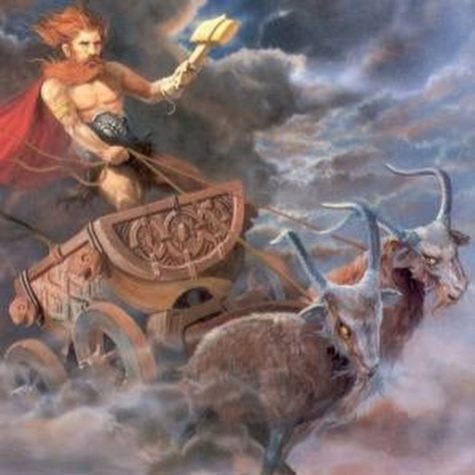
Prayer to Thor for Strength
by Seawalker
Thunder rolls, lightning strikes,
And the hammer flies across the sky.
God of the weather, chariot of the storm,
Master of rain and torrents,
Son of the strength of Mother Earth,
I ask you to grant me that strength for myself.
You who are so great that you cannot walk
Across the Rainbow Bridge without breaking it,
You whose tree is the mighty oak,
O Thunor, grant me that unending sturdiness.
Let me not break beneath the blows of misfortune.
Keep me from being crushed when the powerful
Stomp their large feet on the smaller ones below.
You who are the guardian of the common man,
You who care for the farmers and workers,
Look upon me here in this place where I am
Only one of many, and protect my steps.
Make me resilient and mighty as your own arm,
Make me unbreakable, you who are Friend of Man.
I ask for one small percentage of the vigor
Of the right arm of the Thunderer,
That I might brave the tempest
And stand firm in the gales.
Thunder rolls, lightning strikes,
And the hammer flies across the sky.
Found at Thor’s Shrine
